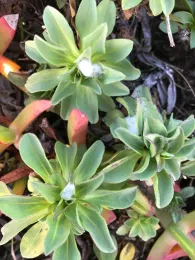
Professor Karban of the Department of Entomology and Nematology, who has maintained a study site at Bodega Marine Reserve in central California since 1982, links the decrease to temperature.
“I've been surveying seaside daisies for spittlebugs at Bodega Bay every spring for the past 35 years and found that the number of these highly visible and previously widespread insects was related to temperature,” Karban said.
However, since the spring of 2006, the UC Davis researchers have found no spittle masses on the Bodega Bay Reserve's coastal prairie. Other researchers have also detailed how sensitive spittlebugs are to environmental conditions.
The meadow spittlebugs, Philaenus spumarius, thrive in cool, moist habitats and suck plant juices, feeding on xylem fluid and excreting most of it as a foamy white mass known as spittle. The mass protects them from desiccation, predation and parasitism. In past years, Karban and Huntzinger found an abundance of meadow spittlebugs feeding onseaside daisy (Erigeron glaucus) and the non-native ice plant (Carpobrotus edulus).

The Karban-Huntzinger research paper, “Decline of Meadow Spittlebugs, a Previously Abundant Insect, Along the California Coast,” is especially important in light of alarming research in Germany dubbed “Insect Armageddon.” In that research, published last October in the journal PLOS ONE, German scientists investigated aerial insect biomass across 96 protected preserves in the country. They found that three-quarters of flying insects had disappeared over the past 25 years.

The earth's climate is warming at a rate of 0.2 degrees Celsius per decade over the past 30 year, according to the National Aeronautics and Space Administration. California's coast has also experienced climate change; the recent severely hot years in the state have also been severely dry. Models of future climates predict that the warming trend will continue and that variability in conditions, for example, droughts, also will increase in frequency and severity.
“Whether the altered climates we face globally will change our ecological communities will depend on how able individual species are to adapt to the new conditions,” the UC Davis researchers explained. “Since meadow spittlebugs were widespread and abundant, we might have assumed that they would not be threatened by climate change. What we have found is that even this species has not been able to adjust physiologically or ecologically. If the pattern they show is common, we may also see surprising changes in the abundance or distribution of other insects as well. These changes are likely to have dramatic and unexpected effects on the functioning of ecosystems.”

